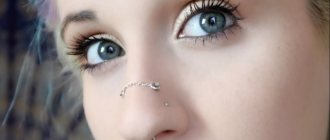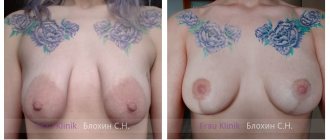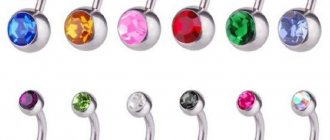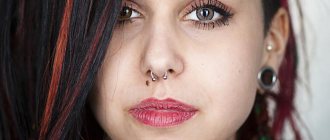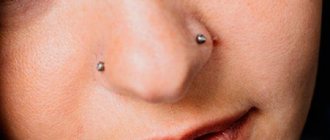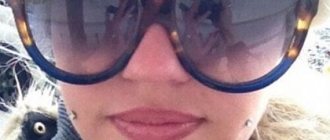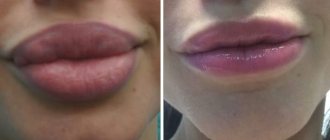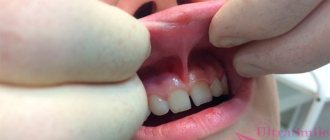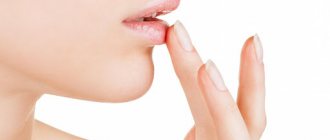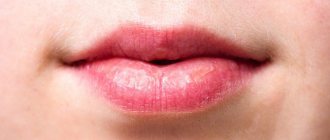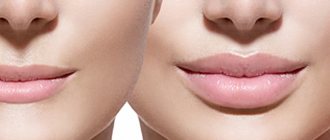Lip piercing has been known since ancient times, it appeared in African and American tribes. Each puncture on the body meant social status, age, merits and exploits. Today the procedure is used for other purposes: aesthetic, religious, for self-expression. Piercing can have the meaning of protest against a certain culture, belonging to youth subcultures, or imitation of an idol.
Ear piercing
Decorations.
For a standard primary piercing of the ear lobe or edge of the ear, you can use absolutely any jewelry: rings, horseshoes, labrets, tunnels. Ordinary bananas for the navel look amazing in the earlobe. Micro rods and rings 1.0mm x 8mm/10mm/12mm are best used for tragus and inner ear cartilage piercings.
This type of piercing is a through puncture on any part of the outer ear. In practice, there are at least ten types of ear piercings:
Lip piercing
Decorations.
For standard primary lip piercings, labrets measuring 1.2mm (1.6mm) x 8mm/10mm made of titanium or plastic are used. You can also use Rings 1.2mm (1.6mm) x 12mm/14mm.
Lip piercing is considered a safe and simple type of piercing, since there are no complex nerves or hard tissues on the lips.
After the puncture, the lip swells within 3-4 days.
For quick and safe wound healing, it is recommended to take vitamin B, rinse your mouth with special means, adhere to a diet (yogurt, porridge), and do not eat salty, spicy, or hot foods.
The pain of the lip piercing procedure is rated on average 6 points out of 10.
What is important to know
If the puncture site hurts for more than seven days, gradually turns blue and swells every day, contact your specialist. Perhaps rejection is already underway. This also applies to long-healed punctures that suddenly begin to fester.
Proper disinfection and strict sterility are the basics of safe piercing. Diseases transmitted through blood will not keep you waiting at the master who pierces somewhere in the entrance with a sewing needle.
Excessive embarrassment is not your friend in this matter. Feel free to ask the master to show your education documents.
If you want to get a lip piercing in Moscow or find out its cost, call or write to +7 (903) 725-13-13 on WhatsApp and Telegram.
Good article? Share it on social networks. It’s not difficult for you, it’s pleasant for us, it’s useful for people
Side lip piercing
This piercing, in a bouquet of all possible variations of facial piercing, is considered one of the most beautiful and aesthetic.
It is now rightfully called one of the safest, simplest and most beautiful types of piercing, because there are no large blood vessels, nerve nodes or endings on the lips, plus, it is very convenient to carry out a puncture and care for it afterwards.
Immediately after the puncture, the guda swells for 1-3 days; the complete healing process after the puncture lasts about 1-2 months. Rings, studs and barbells are used as jewelry for this type of piercing.
Lower lip piercing
Lower lip piercing, or labret piercing as it is sometimes called, was popular in ancient times and was an integral part of religious rituals.
There are horizontal and vertical lower lip piercings. With horizontal, a deep puncture is made as if parallel to the lip, and with vertical, the lip is pierced in the center from the lower border to the central point. Under the lip piercing is also popular today. With this type of piercing, symmetry or a piercing in the center will look best. The decoration for lip piercing is a ball with a barbell, sometimes a ring is used.
Contraindications
Any body art carries a certain health risk. There are some contraindications for piercing. First of all, these are herpes and other skin diseases. It is not recommended to pierce the skin during colds.
Lip piercing inflammation
Other contraindications for piercing:
- Pregnancy. This is not a categorical requirement, but during lactation and during an “interesting” position, interventions in the body are not recommended;
- Blood diseases. If the piercing should heal, the reason lies in the composition of the blood. If platelet formation time is short or other diseases occur, it is recommended to remove the jewelry;
- It should not be done with any reduced immunity.
The main consequences that lip piercing owners face are swelling, suppuration or infection. If a girl’s piercing has festered, she needs to remove the jewelry, apply an antiseptic compress to the wound and take more careful care of the hole.
But, sometimes, inflammatory processes begin not because of improper care, but because of the wrong material of the piercing jewelry or the weight of the earring. For example, if the labrette is too heavy, it can pull on the skin and interfere with normal healing. In this case, you need to change the decor to gold or silver, but thinner and lighter.
Symmetry piercing
Symmetry piercing is a relatively new and very original type of labial piercing. It appeared and developed along with the development of modern subcultures, and now it has begun to be found on the streets more and more often. I use symmetry for decoration and self-expression, both men and women. The puncture is done with a regular hollow or concave needle; the thickness of the needle depends on what kind of earrings the owner of such a piercing has chosen for himself. As a rule, for symmetry, buy a pair of identical earrings, but there are exceptions. Symmetry piercings are done on both the lower and upper lips.
Belly button piercing
Decorations.
For a standard primary navel piercing, bananas or rings measuring 1.6mm x 10mm/12mm are used. Jewelry with dangle earrings or uneven large edges (in the shape of a flower, for example) cannot be used for primary piercings. During pregnancy, it is recommended to change the jewelry to a barbell made of PTFE - flexible Teflon 1.6mm x 16mm/18mm.
A navel piercing is most often a vertical piercing of the upper fold of the abdomen; less commonly, the navel itself is pierced (in the event that the navel protrudes outward).
Care of the wound is very important: you need to keep it clean. For the first time, it is necessary to exclude the sauna, swimming pool, solarium, swimming in ponds, etc.
A small disadvantage of this type of piercing is the inconvenience when putting on outerwear. Clothing can catch the jewelry and damage the skin, so it is recommended to cover the puncture with a postoperative plaster with a pad during the healing period.
Pain during a puncture can be rated 5 points out of 10 according to reviews from people who have had piercings.
Nose piercing
Decorations.
For a standard primary nose wing piercing, studs or microlabrets measuring 1.0mm x 6mm/8mm made of titanium or high-grade 750 gold are used. Rings and horseshoes 1.0mm x 10mm/12mm can also be used for this piercing. Jewelry 1.6mm x 8mm/10mm/12mm is best used for septum (nasal septum) piercing.
Nose piercing is one of the first places in popularity among all types of piercing.
To avoid infection in the wound after a puncture, you must follow some rules: do not scratch the puncture site and remove the earring during healing. A mandatory item is to wipe the wound with an antiseptic liquid 2 times a day. Pain during puncture is estimated at approximately 3-4 points out of 10.
How does the puncture procedure work?
Preparation for the procedure includes choosing a qualified specialist and a salon. Do not do it at home, there is a risk of bacterial infection, the wound will take much longer to heal. In a professional salon, the procedure will take no more than two minutes.
There are no medical contraindications for the puncture site; the pain threshold is individual for each patient.
How the procedure works:
- Tampons are placed under the tongue to reduce salivation.
- Local anesthesia is given (an injection of 2% lidocaine solution).
- Apply an antiseptic: Chlorhexidine Bigluconate or Hydrogen Peroxide.
- The lip is pulled back using a special clamp to ensure symmetry of the pattern.
- The master pricks a needle or catheter and inserts jewelry (it is better to use gold or silver).
- After the procedure, the master must disinfect the puncture site with antiseptics and Miramistin ointment.
Check the sterility of instruments. The needle should be opened in front of the client.
The duration of healing depends on the puncture site, the quality of care after the procedure, and the individual characteristics of the body. In the absence of complications, problem areas heal in 14-30 days.
Eyebrow piercing
Decorations.
For a regular primary eyebrow piercing, it is better to only use microbananas or microbars. Their pattern and thickness (1.0mm x 10mm/12mm) best promotes the formation of a channel in the eyebrows. Barbells and rings 1.6mm x 10mm/12mm are allowed to be used only if you can provide your own piercing with perfect protection and non-invasiveness.
Eyebrow piercing is a type of facial piercing. There are several varieties of this piercing, depending on the type and location of the puncture. Highlight:
- Vertical puncture;
- Puncture at an angle to the eye;
- Horizontal puncture;
Types of punctures
FACIAL PIERCING
Eyebrow piercing
A type of facial piercing in which a puncture is created in the eyebrow area for the purpose of installing and wearing jewelry. Wearing this type of piercing is equally common among both genders. There are different options for the placement of eyebrow piercings, as well as different types of jewelry. The puncture heals on average in 6-8 weeks. Eyebrow piercing is a flat type of piercing due to which there is a possibility of rejection, which can be minimized by carefully caring for the piercing during the healing period.
Options for eyebrow piercings: Vertical piercing: with an evenly vertical piercing of the eyebrow, the jewelry sticks out more from the skin than with a piercing at an angle and more often clings to clothes and hair, and therefore this option of eyebrow piercing is less common.
Jewelry: banana, barbell bent for flat punctures, ring with a ball clasp, segment ring, special jewelry for eyebrows.
Piercing at an angle to the eye: The piercing can be done at various angles depending on the wishes and individual characteristics of the client's anatomy and the preferences of the piercer.
Jewelry: banana, barbell bent for flat punctures, ring with a ball clasp, segment ring, special jewelry for eyebrows.
Horizontal piercing: The piercing is done parallel to or above the main ridge of the eyebrow, depending on the piercer's preference. This type of piercing is considered more complex than angled and vertical piercings.
Decorations: banana, barbell bent for flat punctures.
Anti-eyebrow: a type of flat piercing in which the piercing is made in the upper part of the cheek, under the eye. The jewelry is usually installed at an angle so that the lower ball is closer to the ear than the upper one.
Jewelry: banana, barbell bent for flat piercing.
Forehead piercing Third eye - a puncture is made on the forehead, in the middle, just above the eyebrows.
Jewelry: microdermal.
Eye piercing
A very rare type of puncture, usually performed in the corner of the eyelid.
Jewelry: Micro banana, ring with ball clasp, micro circular.
Nose piercing
A type of facial piercing in which a piercing is made in the nose for wearing jewelry. There are different types of nose piercings with different types of jewelry.
Options for nose piercings: Bridge: Piercing tissue in the bridge of the nose at eye level or between the eyebrows. There are horizontal and vertical puncture options.
Decoration: barbell, barbell bent for flat punctures.
Nose tip piercing: Piercing the top of the nostril from the inside to the tip of the nose.
Decoration: barbell.
Austin Bar: Horizontal piercing of the tip of the nose. Named after the first owner of this type of piercing. Only the tissues of the tip of the nose are pierced; the cartilaginous septum (septum) is not affected.
Decoration: barbell.
Nostril Piercing: Can be performed as a single piercing or a combination of multiple piercings on one or both nostrils.
Rings: rings with a ball clasp, segment rings, nostrils, sometimes labrets, special straight nostrils “bones” for nostril piercing.
Septum: Piercing the central nasal septum between the nostrils with the decoration placed so that it is visible from the nostrils, above the upper lip.
Jewelry: septum clickers, rings with a ball clasp, circulars (horseshoes), sometimes micro bananas or barbells.
Septril: Piercing the underside of the tip of the nose. The puncture is made in the center through an extended puncture of the septum towards the lower flat protrusion of the nose.
Decoration: barbell.
Nasallang: A combination of piercings of both nostrils and a piercing of the nasal septum (septum) united by a common decoration, usually a barbell.
Cheek piercing
A type of facial piercing in which the piercing is made in the cheek. The most popular option is cheek piercing, when a through puncture is made through the facial tissue into the oral cavity. It is common to place two pieces of jewelry symmetrically on both cheeks, so that the piercing creates or imitates dimples on the cheeks.
Decorations: labrets with a diameter of 1.6 mm with one flat side and a ball decoration.
Piercing in the mouth area
Creating a puncture in the mouth area for the purpose of wearing jewelry.
Piercing options: Lip tunnel: superficial lip piercing. The modification is obtained by stretching the lip piercing. Lips can be stretched almost indefinitely, since lips are very different from the tissues of other parts of the body that are capable of such stretching. The diameter of the holes in the lips, and accordingly the size of the lips, can reach 400 mm or more. At the same time, the sensitivity of the lips remains the same over its entire surface, even at enormous sizes.
Decorations: tunnels, plugs.
Labial frenulum piercing: A form of oral piercing in which the frenulum of the upper or lower lip is pierced. Upper lip frenulum piercings are also sometimes called "smiley" piercings because the piercing can be visible when the wearer smiles. Lower lip frenulum piercing, on the contrary, is sometimes associated with frowning and is called “anti-smile”. This type of piercing is easy to install and takes 6-9 weeks to heal. To an outsider, the presence of piercing will be noticeable only if you wear large jewelry.
Jewelry: ring with a ball clasp, segment ring, circular (horseshoe), barbell or banana of small diameter.
Monroe/Madonna: the piercing is done away from the center above the upper lip and imitates a mole. Monroe piercings are also called “Madonna” and “Crawford” piercings in honor of famous women who have moles in the mouth area - Marilyn Monroe, Madonna and Cindy Crawford. An additional variation of this type of piercing is the paired Monroe piercing, in which two symmetrical piercings are created on opposite sides above the upper lip.
Monroe piercing became widespread in the 90s thanks to Reina, the bassist of the band Coal Chamber, also piercing Ashley Massaro, Matia Buena. This type of piercing is more common among women, however, it has a certain popularity among men, among the famous men Cyrus Trace wears it.
The average healing time for a piercing when done by a professional piercer is 8 to 12 weeks, with some healing occurring as early as 3-6 weeks. Compared to other types of piercings, Monroe piercings are relatively painless due to the thinness of the tissue and a small number of nerves located in this area of the body. There is a small risk of hitting the superior labial artery located just above the upper lip.
Decoration: labret.
Labret: Literally meaning “lip decoration”, the piercing is made through the lower lip below the level of the teeth.
Decoration: labret.
Vertical labret (Estrum) - a vertical piercing of the lip. The most aesthetically pleasing look is a puncture made perpendicular to the lip strictly in the center, when the needle enters the border of the lower lip from below and exits in the center from above. Micro bananas of various sizes are suitable for this piercing depending on the thickness of the lips.
Decorations: micro banana.
Horizontal labret is a horizontal lip piercing. Here everything is much more complicated: the puncture runs parallel to the lip and if the needle is not inserted deep enough, the jewelry may come off. In addition, such a puncture takes much longer to heal than a vertical labret or Medusa. The puncture is constantly exposed to the open air, and besides, it is quite difficult not to lick your lips. And when you lick your lips, saliva along with bacteria penetrates the puncture very well.
Decorations: micro banana.
Ashley piercing is similar to a reverse vertical labret, one end of the jewelry is on top of the lower lip, and the other end is inside the mouth. The piercing looks unique because only part of the jewelry is visible, located in the middle of the lower lip.
Decorations: micro banana.
Lowbret - just like a labret, it is done in the lower part of the lip, but is located much lower than a regular labret.
Decoration: labret.
Vertical Lowbret - a puncture is made in the oral cavity between the lower lip and teeth and comes out from below from the edge of the lower jaw. Healing is usually uneventful, although the piercing may seem quite painful at first.
Jewelry: barbell, length depends on the anatomy of the individual.
Chin piercing - jewelry passes through the surface of the flesh of the chin. Sometimes done horizontally, vertical placement is the most common and heals faster. This is actually a variation of the Lowbret piercing.
Decoration: barbell, barbell bent for flat punctures.
Medusa: The name was created in 1990 by Carrick, a hairdresser and model from Toronto, Canada. Medusa is a type of labret in which a puncture is made in the middle of the philtrum, under the nasal septum. One of the variations of the Medusa piercing is Estrum (vertical labret). The jellyfish heals within 3-4 weeks.
Decoration: labret.
Jestrum: is a vertical piercing through the upper lip. It is similar to the vertical labret, but through the upper lip rather than the lower. It was first made by Jesika Bornsen (hence the name) by piercer Derek Lowe.
Decoration: labret.
In addition to the main types, there are combinations of punctures with their own names:
Angel bite - two symmetrically located Monroe punctures; Dog bite - performed by punctures in the upper lip and lower lip, and in parallel; Cyber bite - labret and jellyfish punctures symmetrically located above and below; Dahlia bite - two punctures are made in the corners of the lips; Dolphin bite or disturbed - two symmetrically placed labret piercings using jewelry like the lead singer of the group Disturbed; Snake bite - punctures in the lower lip on both sides symmetrically; Spider bite - performed by punctures on one side in two places side by side; Shark bite - a puncture is made in the lower lip in four places, two on each side;
Tongue piercing
It is one of the most common types of piercings in modern Western culture, after ear piercings.
Piercing options: Vertical tongue piercing - done with a special needle. Piercing the tongue is not very painful, because the tongue is a muscle consisting of longitudinal fibers, and the needle passes between them. However, after the piercing, the tongue may become swollen and tender, often very uncomfortable. Sometimes several punctures are made at once, along the center of the tongue. Healing Time – Complete healing takes approximately 4 – 6 weeks. For the first 3–4 days, it will be difficult to speak due to swelling of the tongue, and for 2–3 weeks it will be difficult to eat.
Decoration: barbell.
Horizontal tongue piercing is exactly what it sounds like. The puncture is done through the tongue (from ear to ear), and not vertically.
Decoration: barbell.
Piercing the surface of the tongue - the tongue is pierced not through, but along or across. Such tongue piercings are possible (although they are prone to rejection and displacement of the jewelry). Particular care should be taken to ensure that the decoration does not interfere with the movement of the tongue. There are varieties of this type of piercing: Lingum Piercing - a term coined by John Cobb in 1993, a piercing on the underside of the tongue. This placement is less prone to rejection than others. Scoop Piercing is the name for a horizontal piercing on the surface of the tongue.
Decorations: barbell, barbell bent for flat punctures, rings with a ball clasp, segmental rings.
Tongue tip piercing - sometimes the tip of the tongue is pierced. This type of piercing can cause serious damage to teeth. Care must be taken when choosing placement and decorations.
Decorations: spiral, circular (horseshoe), ring with ball clasp, segment ring.
Puncture of the frenulum of the tongue (frenulum) - a puncture is made through the tissue of the frenulum located under the tongue in order to wear jewelry in it. The piercing procedure is quite simple and performed quickly, however, in some cases the piercing is rejected over time. For some people, this type of piercing is impossible due to their anatomy.
Decorations: banana, circular (horseshoe).
Uvula piercing
The puncture is made in the uvula (a small pear-shaped projection at the beginning of the throat).
Jewelry: ring with ball clasp, segment ring, circular (horseshoe).
Ear piercing
Creating a puncture in one or another part of the outer ear for the purpose of inserting and wearing jewelry.
Ear piercing options: Earlobe piercing - The lobe is the soft, fleshy lower part of the ear and consists of connective fatty tissue covered by skin. Almost painless procedure.
Jewelry: earrings, ring with ball clasp, segment ring, barbell, banana, circular (horseshoe), etc.
Helix piercing: A piercing in the helix of the auricle or in the upper part of the ear (cartilage). As a rule, the piercing is performed with a small hollow piercing needle.
Jewelry: rings with a ball clasp, segment rings, circular rings (horseshoes), labrets.
Snug piercing is a puncture of the lower cartilage, slightly above the anti-tragus (also called anti-helix).
Jewelry: rings with a ball clasp, segment rings, circular rings (horseshoes), labettes.
Forward Helix piercing is a piercing of the helix of the ear at a distance close to the head.
Decorations: ring with ball clasp, segment ring, labret, circular (podkle).
Daith - the puncture is located inside the auricle and passes through the middle cartilage. Daith piercing was created in 1992 by Eric Dakota and his client. Eric Dakota's client, who studied Hebrew in college, was the first to name this piercing ("Daath" meaning "knowledge"). Her reasoning is that a piercer must be very smart to do piercings. The woman sincerely believed in the Indian doctrine of piercing, which has existed for approximately 3,000 years: rings are inserted into holes in the body as a “gate guard.” They can be magically charged the moment they are pierced to act as a "filter" for whatever may pass through those holes. In the case of the ear, appropriately placed and charged rings can filter out nonsense that the interlocutor says and allow intelligent thoughts to pass through. Eric and the client were guided by this teaching when creating this piercing, and the woman gave it a name in Hebrew: Daith. A true Daith should be made so that the bottom of the ring extends straight out of the ear canal and is not visible behind the tragus. If the entrance and exit holes of the ring are visible, then the puncture is not a true Daith. The technique of this piercing is very progressive and requires a specially curved needle, it was developed by Eric Dakota.
Jewelry: ring with ball clasp, segment ring, micro banana, micro circular (horseshoe), septum clicker.
Industrial: piercing any two holes connected by one straight piece of jewelry, but more often two upper cartilage piercings. One is done quite close to the head, the second down the cartilage, on the opposite side of the ear.
Decoration: industrial bar.
Tragus piercing or Tragus piercing: piercing of the part of the outer ear located directly opposite the auricle. The puncture is made with great care so as not to touch the tissues located deeper than the tragus.
Jewelry: barbell, labret, small ring with ball clasp, segment ring, circular.
Antitragus piercing: This is done by making a hole in the inner part of the ear cartilage. The puncture is made in the antitragus itself - the part of the cartilage located opposite the ear canal. This type of puncture is directly similar to the tragus puncture; these punctures are made almost identically and require extremely similar care. By analogy with the English name, the antitragus puncture is also called the Antitragus puncture.
Jewelry: small ring with ball clasp, segment ring, labret.
Rook is an internal puncture of the ear cartilage, located in the upper part of the auricle approximately 12-25 mm from the top of the ear.
Jewelry: ring with ball clasp, segment ring, banana, barbell.
Conch - located inside the auricle, slightly above the earlobe. When choosing where to place this piercing, it is important to consider where and how the jewelry will be placed at the back of the ear. If placed incorrectly, they can cause discomfort, especially during sleep.
Jewelry: ring with a ball clasp, labret, tunnel or plug of small diameter.
Tunnels: the earlobe is pierced with a needle, a labret or ring is inserted until the puncture is completely healed. Then the canal is stretched with tappers, after which a tunnel or plug is inserted. Particularly large diameters can be cut with a scalpel. A tunnel with a diameter of up to 8-10 mm is most often tightened after removal; if it is larger, surgical intervention may be necessary, although the characteristics of each person’s body play a large role in this. If the diameter of the hole is too large, then the inner wall is cut to close it, after which the filling takes place quite quickly. Holes that are too large are simply sewn up.
Decorations: streamers, tunnels, plugs, fangs and claws.
